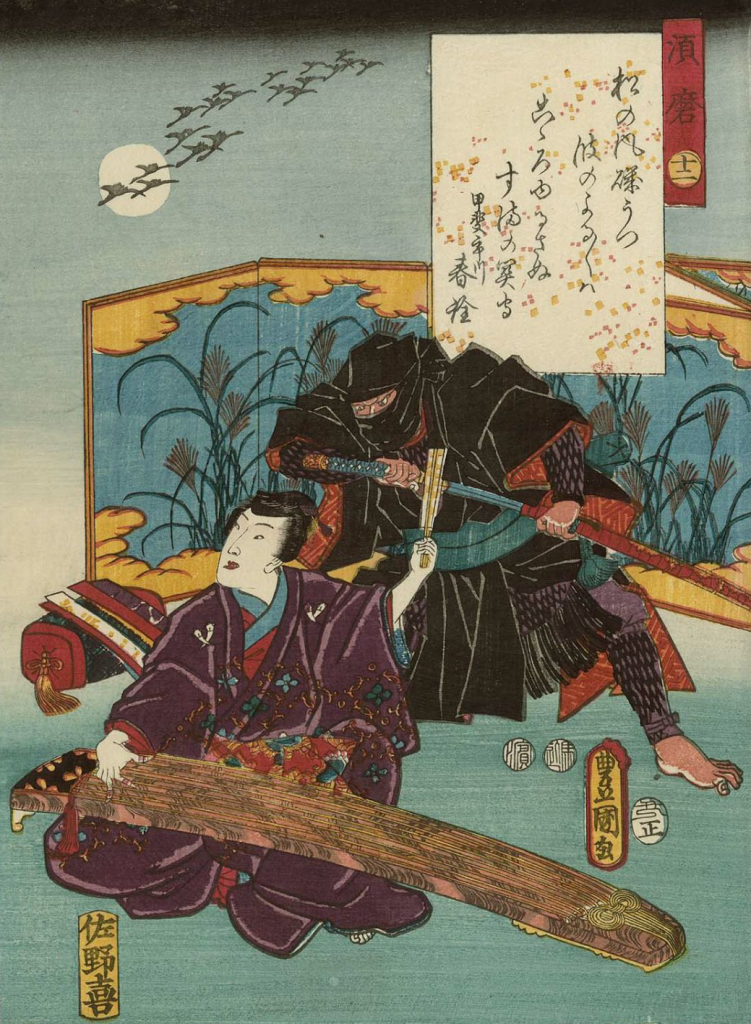Ninjutsu and the Bujinkan

An ukiyo-e woodblock print from 1852 by Utagawa Kunisada depicting a shinobi no mono preparing to assassinate Prince Genji.
Due to the fame (and infamy) of this art, and how famous the Bujinkan has become because of it, a separate section ought to be dedicated to saying a few words about this fascinating subject—though it is far too vast to be dealt with to any greater extent here.
While Bujinkan Budô has often been referred to as “ninjutsu” (especially back in the 1980s and 1990s), this is quite a misnomer as the main focus of our art is the kakutôjutsu (“Fighting Art”, or unarmed combat) and weapons use found in our various ryûha. Shinobi no jutsu (an older pronunciation of the word ninjutsu) is not an art of combat but rather one of covert warfare and thus rarely contains teachings on direct combat—whether unarmed or armed. Although unarmed combat as well as combat with the common weapons of the time were certainly matters in which the shinobi no mono (an older pronunciation of the two characters which make up the word ninja, the latter being a more modern reading thereof) were highly skilled, as such would have been a requirement of any important soldier of the day, fighting techniques are not what identifies this art of covert warfare. What identifies ninjutsu are techniques and principles of infiltration & exfiltration, information gathering, sabotage, and guerilla warfare strategy & tactics such as ambushes, night raids/night attacks, the setting of traps and such like.
Within such an art, various other important elements are found, like kajutsu (“Fire Art/Techniques”—the manufacture and use of various fire tools and explosive devices, as well as strategy & tactics of arson as a weapon and tool for sabotage), suijutsu (“Water Art”—the employment of infiltration & exfiltration techniques by means of water, and thus also the utilisation of a variety of tools in that regard), shinobi no yakuhô (“Shinobi Method of Medicine”—the use of flora & fauna for the treatment of wounds, ailments and other circumstances, as well as the application of such to, conversely, create poisons ranging from irritants and nuisances to those of the deadly variety), seizon senryaku (survival tactics—the manufacture and use of “military rations”, tracking, navigating in the wild, building fires, obtaining and preparing food in nature, drinkable water etc.), climbing techniques, coded communication and other things.
Togakure-ryû, the oldest of the Bujinkan schools of shinobi no jutsu, or ninjutsu, is rather unique in this regard as it contains a few unarmed combat techniques as well as a few armed techniques for some of the more special weapons encountered specifically in this ryûha. Though these techniques are rather simple in nature and are more for the sake of conveying certain principles than for the techniques themselves, shinobi no mono (or shinobi) typically acquiring their skills in unarmed and armed combat from other ryûha specialising in such—Gyokko-ryû and Kotô-ryû being good examples of this as they are said to have been extensively practiced by certain shinobi families in Iga. It also needs to be kept in mind that the Togakure lineage, while mainly being one conveying the art of shinobi no jutsu, also contains teachings of budô taijutsu as a separate matter. There is a hidensho, or secret written transmission, within Togakure-ryû entitled Togakure-ryû Ninjutsu Budô Hidensho (『戸隠流忍術武道秘傳書』), which alludes precisely to that matter.
Another ninjutsu ryûha of ours, Gyokushin-ryû Ninjutsu, also contains various unarmed combat techniques, but this is not really because of the shinobi no jutsu “curriculum” containing these yet rather because the school is also one of koppôjutsu (“Bone Method Art”, or the art of attacking the bone structure in the human body). So, it is technically both a ryûha of ninjutsu and a ryûha of a specific style of unarmed combat similar to Kotô-ryû or Gikan-ryû—not unlike how Togakure-ryû is a school of ninjutsu and one of taijutsu and bukijutsu at the same time. Such a thing is not unusual among certain families, clans and certain warrior art lineages where a ryûha would have both a body of kakutôjutsu (hand-to-hand combat) teachings, kenjutsu (swordsmanship) teachings, bôjutsu (staff technique) teachings etc. Tenshin Shôden Katori Shintô-ryû, Yagyû Shinkage-ryû and Asayama Ichiden-ryû are just three more examples of such.
Ninjutsu is what originally made Bujinkan Dôjô and Bujinkan Budô Taijutsu famous because of how rare ryûha of shinobi no jutsu are today. Very few are still in existence and out of these, the Bujinkan was in possession of an entire number of three of them! This, obviously, made Bujinkan Dôjô a famous martial arts organisation, but ironically, not much emphasis is placed on the teachings of these schools today due to our focus on direct combat as opposed to the strategy & tactics of covert warfare. It is still, however, an incredibly important part of our martial heritage and as such, there are still instructors in the Bujinkan who convey these teachings of the shinobi. Lenny Pedersen, the Shinseikon Dôjô founder and instructor, is one of these individuals as the subject of ninjutsu and the shinobi is one of his greatest passions in life, and precisely what originally brought him to the Bujinkan back in 1995 when he was only a teenager.
Lenny has trained under teachers in Japan who still convey the principles, techniques and philosophies of the shinobi art and has additionally spent years studying various ninjutsu no hidensho, or secret written transmissions of ninjutsu (i.e., the old books and scrolls containing some of the core teachings of the given ryûha). He has studied those of ninjutsu ryûha within the Bujinkan as well as those of ryûha of shinobi no jutsu not within the Bujinkan. He is adamant about conveying the “shinseikon”—the “true spirit”—of ninjutsu and preserve this art, and therefore passes it on to his higher-ranking students.